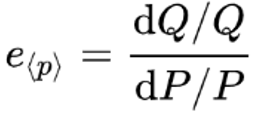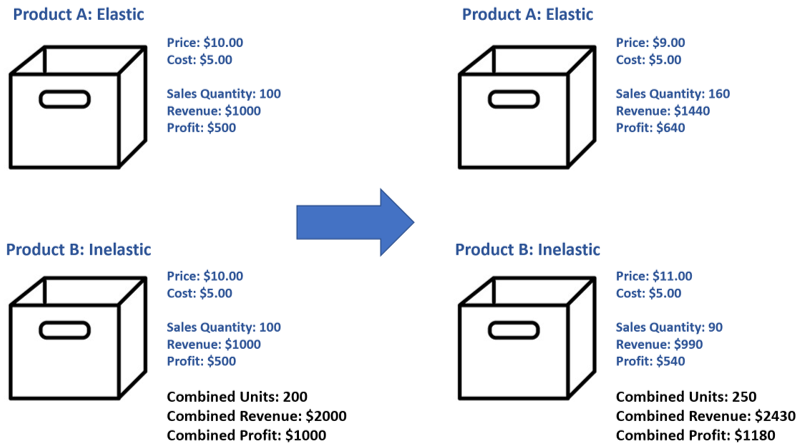Making Profitable Pricing Decisions Using Price Elasticity of Demand
How to determine the price elasticity of demand for your products, and what pricing tactics you can use for a strong foundation
Newton’s third law of motion states that for every action there is an equal and opposite reaction. Although this law is about objects in motion, the same principle can be applied to pricing. When an action drives prices up, there is typically an opposite reaction and sales go down. Conversely, when prices go down, it can lead to increased sales.
This is one of the most basic concepts in retail pricing and has helped merchants balance sales and margin objectives since the earliest marketplaces in human history. Now, where Newton’s third law doesn’t apply to pricing is the word equal. Changes in price won’t necessarily have an equal reaction in sales. What determines that level of reaction is called elasticity.
What is Elasticity?
Price elasticity of demand is used to measure the relationship between price and demand, and how changes to one will affect the other. All products will have different responses in consumer demand to price changes. Therefore, it’s critical to understand those differences when making important pricing decisions. When utilized well, price elasticity can drive enormous value for retailers.
If a product is elastic, that means changes in price will have a higher impact on demand. Typically, products with multiple substitutes and low brand loyalty will have a high elasticity. For instance, toilet paper at the grocery store, where shoppers can easily compare prices on multiple brands.
However, if a product is inelastic, pricing changes will have a relatively low impact on demand. Take for example, pain reliever at a convenience store. If someone pulls into a gas station to find relief for a headache, they aren’t going to balk at a $0.10 increase and drive to the next store.
Calculating Elasticity of Demand
The basic formula for price elasticity is:

Technically this formula will produce a negative elasticity, or elasticity coefficient, because of the opposite relationship between price and demand. However, to make it an easier concept to understand and use, convert the calculations to a positive value and follow these guidelines: Products with an elasticity greater than 1 are elastic, and products with an elasticity less than 1 are inelastic.
This may seem straightforward, but the reality is, true elasticity calculations are much more sophisticated and do not produce linear results. There are other considerations and factors at play that affect the price elasticity of demand. Things like promotional vehicles, seasonality, celebrity endorsements, and hard limits to demand, take calculating elasticity beyond a simple formula. This is where Revionics can help by leveraging AI to re-model elasticities as demand shifts.
Using Elasticity for Pricing Decisions
Knowing the elasticity of your products is key to determining how customers will react to price changes. Equipped with that information, there are two strategic pricing moves you can make to increase profits.
- For elastic products, reduce prices to drive more sales volume. This will also improve your price perception in the market.
- With inelastic products, increase your prices to drive higher margins with limited impact on units sold.
The following should illustrate how powerful these moves can be using two items with similar prices, margin, and quantities, but different elasticities:

As the diagram shows, raising prices on inelastic products while reducing them on elastic products can drive higher overall units, revenue, and profits. While the impact on these two low volume items may not seem like much, think about the results you could get from applying elasticity-informed decisions across an entire product catalog. A deep understanding of price elasticity of demand and how it varies by pricing zones, regions, or store formats will enable retailers to drive enormous value from pricing activities.
Succeeding with Price Elasticity of Demand
Being able to effectively calculate millions of elasticity values and dynamically adapt them as demand shifts is impossible without the help of an AI pricing platform. However, with the right AI pricing solution, retailers can assure more value generation, improved forecasting capabilities and the ability to leverage powerful scientific optimizations. At Revionics, we can help you find the correct balance of price increases and decreases to maximize results and hit key business objectives.
Matthew specializes in Pricing & Retail Strategy, Corporate Strategy & Customer Focused Solutions. Matt is a leader in Pricing Strategy Development, Business Strategy Development & overall Corporate Strategy. Matt has a strong merchant background and experience with C-Level presentations. He has 20+ years of experience in Retail encompassing Consulting, Buying, Pricing, and Marketing across a variety of retail verticals, industries, and regions. Having lived and worked in France, Germany, Hungary and South Africa (with additional long-term engagements in other markets), Matt spent the last decade driving customer-focused success at Revionics.
